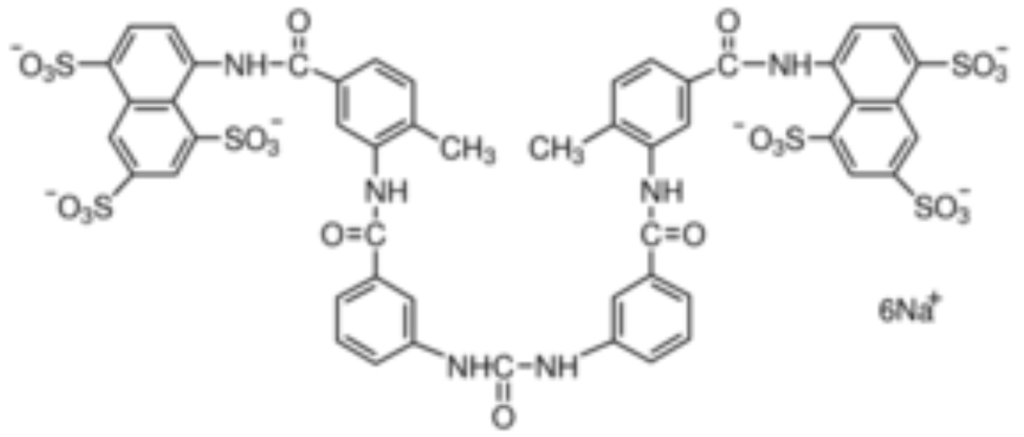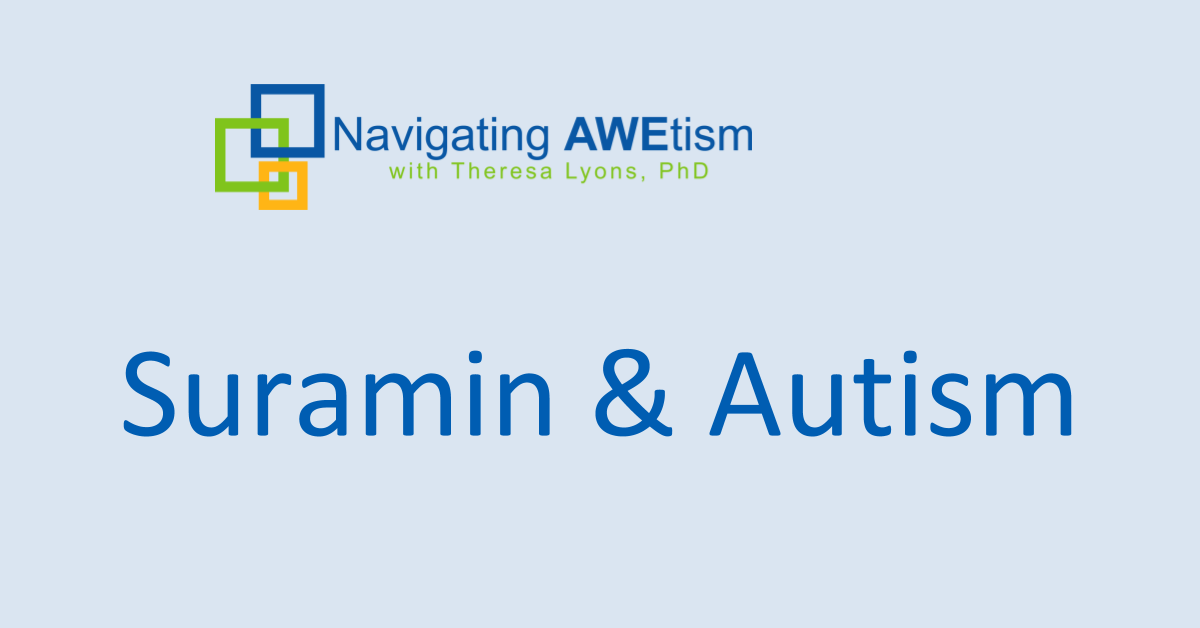Warning: This information is not for beginners. So if your child is not on a special diet, then this is really not for you. This is information from a clinical trial. So this is from 2017. It’s cutting edge. This is not FDA approved for autism.
The mechanism of action that I’ll explain in a few minutes is commonly addressed in other ways. So please work with a knowledgeable functional medicine practitioner and let’s learn about Suramin.

Here it is. It is quite a large molecule, as you can see. And one of its best-studied actions is an inhibitor of purinergic signaling, which I’ll explain in a few moments. This drug, Suramin, was developed in 1916, so it has been around for well over 100 years and currently, it’s used to treat African sleeping sickness.
Why Suramin? Great question. Autism is heterogeneous, right? You’ve probably heard the expression ‘if you see one person with autism, you’ve seen one person with autism.’
However, scientists postulate that core symptoms have similar root causes and they came up with this hypothesis called the “Cell-danger” hypothesis. And so basically what that says is regardless of the stress or the danger to the person was caused by a virus or bacterium or genetic forms of mitochondrial disease or neurodevelopmental disorders with complex gene-environment pathogenic mechanisms, basically, that just means regardless of where the stress is coming from, they postulate that it all traces back to the mitochondria.
These scientists are saying, listen, it doesn’t matter how the person presents. Everyone is going to present differently with different symptoms. There is one root cause. This is their hypothesis. And their hypothesis is that there’s still danger involved. So if you understand how the cell reacts when it’s under danger, then you can optimize that. Then you’ll have a better handle on optimizing the rest of the biology in the person.
What do mitochondria do
You’ve probably heard of it. You’ve probably heard how important they are and in some cases how fragile they are. Mitochondria, they are involved in innate immunity -that’s the immunity that you’re born with. And they’re also involved in response to stress via regulation of certain molecules.
And this biology can get complex real quick. But in a nutshell, that’s what mitochondria do. Molecules such as ATP are also co-released with neurotransmitters such as glutamate, dopamine and serotonin. So you have mitochondria who use molecules such as ATP. ATP is about energy. There’s a high concentration of ATP in the cell when the cell becomes injured.
Obviously that ATP can exit the cell and typically the amounts of ATP outside of the cell are quite low. So when a cell gets injured and ATP then can be outside of the cell, the body can recognize this as an injury, as stress, as danger. And molecules such as ATP, they’re also released with neurotransmitters. So this is where you can start to see some differentiation in symptoms for people based upon the hypothesis that the cell danger is the root cause.
This is what mitochondria do and Suramin inhibits this stress response signaling. When we want to tell the body, “You’re not in danger”, Suramin does that.
Low-Dose Suramin & Autism
There was a clinical trial done. It was completed and published in 2017 about low dose Suramin and autism. And it was called the “Suramin Autism Treatment-1 (SAT-1) trial.
And it was double blind, placebo controlled. Those are gold standards for any type of clinical trial.
And this study was a translational pilot study for safety and activity. Phase one, phase two clinical trials are usually on the small side. First, you got to test safety to make sure things are still safe, and then you want to see some activity. That was the goal of this clinical trial -there were 10 male subjects with autism and they were the ages of 5 -14 years.
And what they did was they paired each of that ten. So you have five pairs and they were paired by age and IQ and autism severity. Trying to have that pair be as similar as possible and then they randomize and each of the pair received either intravenous infusion of Suramin or saline. So again, it was placebo controlled. So that means half the subjects were getting a placebo, just saline delivered intravenously while the other half were getting suramin.
Suramin Results
There were no serious adverse events. There were some rashes, some headaches, peripheral neuropathy, things like that. But there were no serious adverse events.
There was an improvement in the ADOS-2 scores for the Suramin group & in the placebo group there was no change. That’s what we would expect.
Secondary outcomes also showed improvements in language and social interactions, as well as decreased restrictive or repetitive behaviors. So the results were positive. You saw an improvement in the group that had Suramin. You saw no change in the placebo. So there was no placebo effect. There were no adverse health events. So that shows that there is some safety involved in Suramin at this particular dose in the autism population.
And there were also secondary outcomes reported by parents showing improvements in a variety of things. However, parents reported that after Suramin treatment, the rate of language, social, behavioral and developmental improvements continued to increase for three weeks. So you have one infusion and for three weeks after that, the parents were stillseeing improvements.
However, it gradually decreased back towards baseline over the next three weeks. So there is an improvement for three weeks. And then after that three weeks, things were starting to go back to the way they were before treatment – they were returning to baseline.
So Suramin, even though it showed activity in improving certain symptoms for those with autism when it was stopped, the improvement stopped and there was a return to the baseline.
Conclusions
“The safety and activity of low dose Suramin showed promise as a novel approach to treatment of autism in the small study.”
And as a parent, it’s important to remember that:
1. You’re probably doing so much already for your child. If you’re watching this video, you’re doing a good job. You’re looking for answers, you’re finding things out. So just take a moment to celebrate and acknowledge how much work you are doing.
2. Suramin is not the golden ticket. It doesn’t change things for the long term. It’s just showing some promise. So there’s many different ways that mitochondria can be influenced. There’s many different ways to ensure healthy cells and to ensure that cells aren’t being damaged and in danger. Suramin is not the only answer. I know it gets talked about from time to time. And it certainly showed promise.
But remember, these changes were not long term changes, and that’s what you want for your child, you want long term changes, you want your child to start smiling and keep smiling. It’s possible. Keep going.




